The other day, I was chatting with a fellow Chevrolet Bolt EV owner during a charging session, and he reminded me that I was just about to hit the three-year anniversary of owning my 2017 Bolt EV. While I wasn't the first person to receive their Bolt EV, I did get mine in late December of 2016.
Rather than make this story a formal review of the 2017 Chevy Bolt EV as a vehicle (I recently posted a 100,000 mile update video), I instead want to share some of my most compelling Bolt EV adventures over the last three years. If applicable, I'll share videos, but some of these stories have never been published or told before.
I’ll also include the context of the time in which those trips were taken. For instance, at the time I purchased my Bolt EV, there were numerous 200+ mile gaps between public chargers and the 125 A “50 kW” DC fast chargers were the fastest available. Also, the only trip planners available at the time were very rudimentary, most of the public charging providers didn’t have apps, and not a lot was known about the Chevy Bolt EV’s charging speed or efficiency.
Initially, I was going to provide a short synopsis of each adventure; however, in order to do each road trip justice while still keeping the story length manageable, I’ll be sharing these as a series. This will also make these stories easier to reference for those electric vehicle owners who are planning similar trips today.
For this story, I will be sharing my first 1,000-mile trip in my 2017 Chevrolet Bolt EV from Southern California to Northern California.
Chevy Bolt EV First 1,000-Mile Trip in January 2017
As I described in an earlier story, prior to reserving and purchasing my 2017 Chevy Bolt EV, I researched whether it would be able to reasonably complete my regular 1,000-mile trip from Southern California to Northern California and back. What I found is that I had two routes available to me (Highway 99 and Highway 101), and in January of 2017, I was able to test out my theory for the first time.
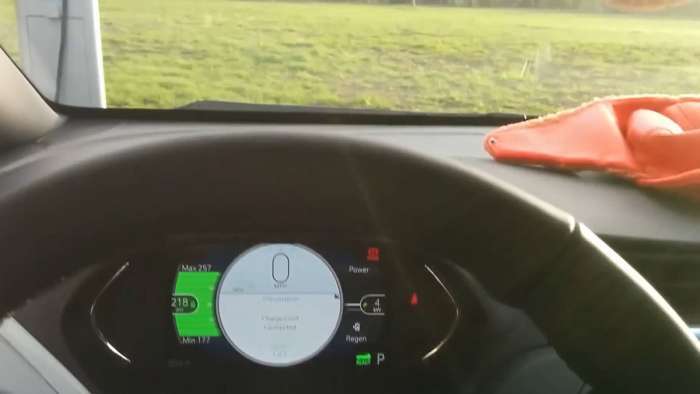
The trip would take me from my workplace in eastern Ventura County up Highway 101 to I-680. From there, I would connect with I-5 by crossing over on I-80 to I-505. After about 500 miles, I’d end up at my family property in Northern California, which at this time still only had 120 V charging available. Three days later, I would return to Southern California by the same route.
For reference, I completed this trip months before the now widely shared article describing how inadequate the public charging infrastructure was for long distance travel, even in California. In fact, part of my frustration with this trip’s lack of coverage by the EV media is that a number of lessons that I learned on this trip and attempted to share could have alleviated a lot of stress for other electric vehicle owners.
Ventura County to San Luis Obispo
I headed out of Ventura County with a full battery at just after 4 pm, but unfortunately, this wasn’t soon enough to beat traffic. I was confident that my 2017 Chevy Bolt EV could make the 159 miles to San Luis Obispo even at freeway speeds, but in this case, it took three and a half hours just to get to this first stop.
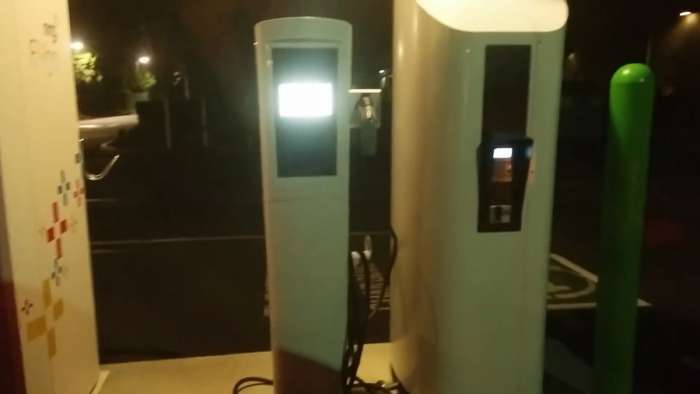
It was 7:35 pm by the time I arrived in San Luis Obispo, meaning my average driving speed was only 45 mph despite most of the drive being on 65 mph freeway. Due to the slow driving speeds, my average efficiency was still over 4 mi/kWh, and in fact, I still had 40% battery left by the time I arrived.
Even at that time, I had recognized that stopping at San Luis Obispo was too early for a Bolt EV leaving from Ventura County; however, my understanding at the time was that the next public DC fast charger that was faster than 24 kW was in Gilroy, which is another 160 miles north. Later, I learned that a faster EVgo charger was available in Salinas, and it was only about 130 miles north.
First DC Fast Charge on My Chevy Bolt EV
I had owned my Chevy Bolt EV for less than a month at this point, so this stop was the first time I was able to actually use a DC fast charger. I had planned to test it out on a previous occasion, but the only CCS port available at my local EVgo charger was occupied at the only time that would have been convenient.
I didn’t know this at the time, but arriving at 40% battery was enough to get in under the Bolt EV’s typically charge rate step down that occurs at around 50% battery. The activation was more difficult than it needed to be because, at this time, EVgo’s screensavers didn’t provide onscreen instructions. It took me a few seconds to realize I needed to plug in to bring up the screen, but one swipe of my RFID card activated the charger right away.
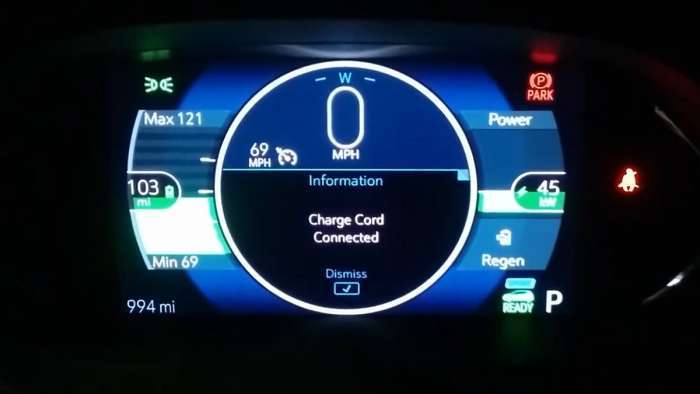
I wasn’t planning for this to be a long stop, but I did step away from the car to use the bathroom after a few minutes. By the time I returned, though, I found that the charge session had ended, and my Bolt EV was no longer charging. At the time, I knew that EVgo’s free charging sessions for participating automakers were limited to 30 minutes; however, I had paid for a full membership and was paying for the energy I was consuming. EVgo would later extend charging session limits to 45 minutes during peak times and 1 hour during off peak times for members; however, at this time, all charging sessions – regardless of membership status or time of use – were limited to 30 minutes.
It wasn’t abundantly clear in EVgo’s materials that their session time limits were set to 30 minutes for all users. This is a point of confusion among EV owners that persists to this day, and at that time, I was still under the impression that it was just a fluke with the San Luis Obispo EVgo charger.
I restarted the session when it was at 69%, and it was at this point that I had noticed the charging speed had throttled down to 24 kW. With the second 30-minute session, I charged up to 85% battery, and by the end, charging rate was only 16 kW. I headed out about 8:45 pm.
San Luis Obispo to Gilroy
I was able to keep a much faster pace due to the lack of traffic, I arrived at Gilroy at 11:20 pm. That meant that my average driving speed for this section was about 64 mph, or nearly 20 mph faster than the first 160 miles.
As a result, my efficiency on this 160-mile leg of the trip was far worse, and despite leaving San Luis Obispo with 85% battery, I arrived with only 3% battery. This time, I only saw 3.3 mi/kWh, and while that was partly due to driving speeds, it was also due to weather (the temperatures we dipping to the high 30s and I was driving through a strong crosswind).
When I activated the EVgo charger in Gilroy, I also learned that I had been misled. PlugShare postings had listed these chargers as “60 kW,” and I was working under the impression that they would be faster than the charger I used in San Luis Obispo. Unfortunately, these units were only 100 A chargers, which will only provide charging speeds of about 35 kW on the Chevy Bolt EV.
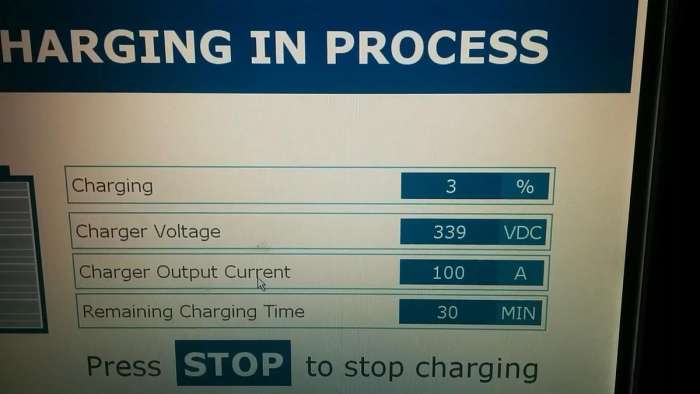
This was also my planned dinner stop, so I walked across the street to grab some food while I charged. That turned out to be another mistake on my part, as I learned mid-dinner that the 30-minute cutoff at the San Luis Obispo EVgo charger wasn’t just a fluke. The MyChevy app let me know that my car had stopped charging, so I paid my bill as quickly as I could and rushed back to the charger taking my food to go. Still, this entire incident cost me close to 30 minutes of time spent not charging.
When I returned to my Bolt EV, it was only at 30% battery despite completing a 30-minute session. This is when I realized two things. First, the difference between 100 A and 125 A chargers for the Chevy Bolt EV was significant. Second, EVgo's 30-minute session model was no longer appropriate for long-range electric vehicles with larger batteries, especially on their slower DC chargers.
I reactivated the charger and finished my dinner that I had brought back with me from the restaurant. It was during this session that I first realized that the Bolt EV would draw additional power from the charger to run climate control and battery conditioning after its charging rate had stepped down.
All told, between the wasted time due to the charging session cutoff and the slower charging speeds, this stop took nearly 2 hours, and it was well after 1:00 am by the time I left.
Gilroy to Vacaville
My next stop on the trip was the EVgo charging site located at the Vacaville Premium Outlets at the I-80 and I-505 junction. This leg of the trip was only 114 miles, and I arrived at the chargers at 3:05 am with 20% battery. The average driving speed for this leg of the trip was a little over 60 mph, and my efficiency was still 3.3 mi/kWh thanks to colder temperatures.
Luckily, the EVgo chargers at this site were 125 A, and I was able to successfully activate the charger; however, I continued to encounter EVgo's 30-minute cutoffs. I started a second DC charge session, but I cut it short because I had already reached the 24 kW charging rate step down at close to 70% battery.
At about 4:00 am, I moved to a nearby 24 kW ChargePoint charger located at an ARCO gas station. I had several reasons for doing this. First, I needed to use the bathroom, and all of the facilities at the Outlets were closed. Second, I wanted to test out the ChargePoint unit just to see how it worked and compared to the EVgo chargers I had used this trip. And third, I only had 120 V charging available at the property.
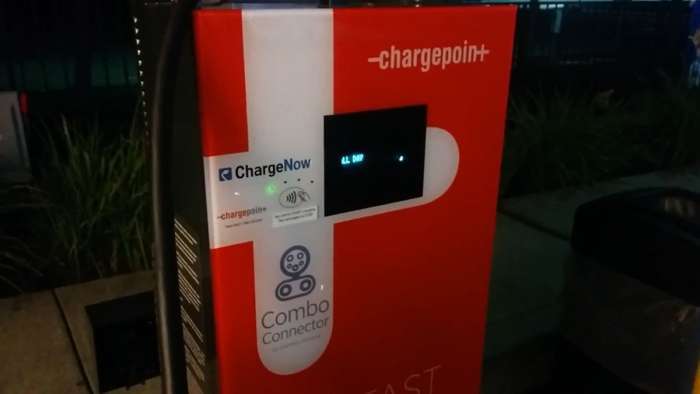
At that point, I already had nearly five years of experience driving the Chevy Volt, so I knew that charging a Chevy Bolt EV from near empty on a 120 V outlet would take most of my three-day weekend. I also knew that, at that time, there were only three public DC fast chargers within 90 miles of my destination, and all of them were these same ChargePoint 24 kW CCS units.
I charged up to 85% at the Arco ChargePoint in Vacaville and headed out at 4:30 am.
Vacaville to Home
The final leg of the trip was just under 100 miles; however, it was nearly all 70 mph freeway with 1,000' feet of net elevation increase and Northern California temperatures in January can drop well below freezing.
Overall, this last leg of the trip was uneventful. I didn't encounter any traffic at this point, and I arrived at just after 6:00 am with about 35% battery. The average driving speed for this last leg was over 60 mph. I forgot to reset my trip efficiency, but since Gilory, it had dropped to 3.1 mi/kWh.
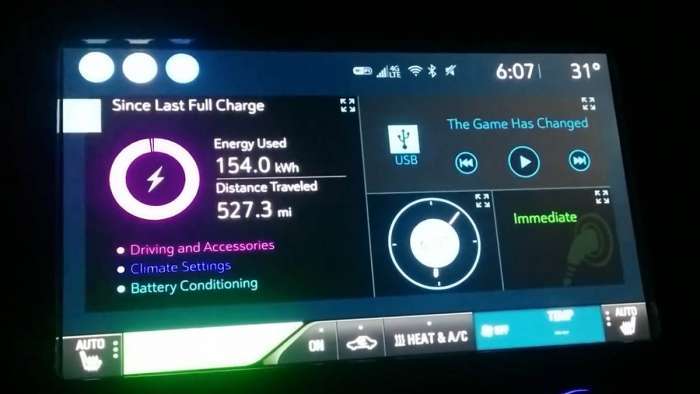
The total trip time was 14 hours for 527 miles of driving. The average speed was only 37mph; however, given the traffic leaving Southern California, the delays due to interrupted and slow chargers, and charging up more than necessary to reach my destination, the time seemed appropriate. Just those delays alone added about 2 hours to the trip.
Chevy Bolt EV Back to Southern California
Over the years, I’ve lost some of my data for the return trip to Ventura County; however, I followed the same route. Even though I was plugged into the Level 1 AC charger for most of the weekend in Northern California, I wasn't able to charge to full because I had also done about 150 miles of driving while I was in the North State. As a result, I left to head back at about 1:00 pm with only 50% battery.
Because I left with such a low battery, I needed to stop at the EVgo charger at the Vacaville Premium Outlets as my first stop despite its only being about 100 miles out. With mostly freeway driving, I knew that was still pushing my Chevy Bolt EV’s limits on 50% battery, so I drove about half of the way on Highway 99, which is a 55 mph road.
This leg took about 1 hour 45 minutes, and I arrived at the Vacaville EVgo at about 2:45 pm. This was an average driving speed of about 54 mph. I spent about 1 hour 15 minutes charging, and left at 4:00 pm with about 85% battery. I intentionally charged longer at Vacaville because of my previous experiences in Gilroy.
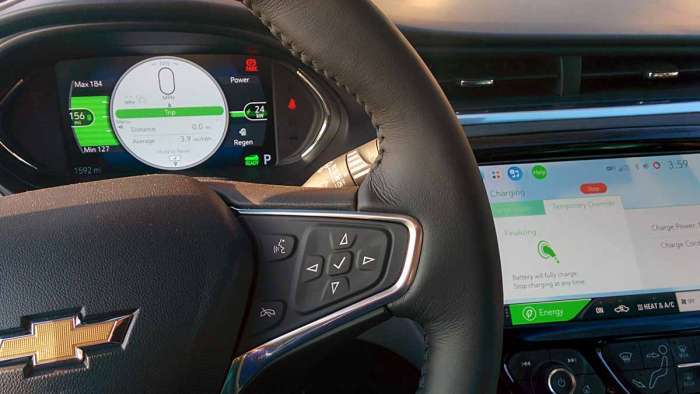
I again stopped at the Gilroy Premium Outlets, 115 miles to the south. This time, I charged up to 80% battery before leaving at about 7:15 pm.
On the return to the San Luis Obispo EVgo, I stopped by the 24 kW ChargePoint unit in King City. This site is about 75 miles south of the Gilroy Outlets, and I arrived at just before 9:00 pm. For this leg, my efficiency was only 3.4 mi/kWh efficiency. I only charged for a few minutes, and I left at about 9:15 pm.
It was another 84 miles to the EVgo chargers in San Luis Obispo, but I had nearly 60% battery leaving King City. I lost some of my data from this section of the trip, but I do recall that my efficiency took a hit due to faster driving speeds, cross winds, and 30 to 40 degree temperatures. Still, I made it to the San Luis Obispo EVgo alright.
My apartment is just 120 miles from San Luis Obispo, and because I do not have access to charging at my apartment in Southern California, and I charged up a little extra in San Luis Obispo. I finally arrived in Ventura that night at 1:30 am, so the return trip took me 12 hours 30 minutes to go 484 miles.
1,000-Mile Chevy Bolt EV Trip Summary
Over the course of the three day weekend, I had driven 1,152 miles with an overall efficiency of 3.4 mi/kWh. I had learned a lot about the Chevy Bolt EV and public charging infrastructure, and I shared a final summary of my thoughts on the trip on my YouTube channel in January 2017
.
I was fairly critical of the public charging infrastructure at the time, but I was optimistic about how it would improve in the coming years. While that initial video reached nearly 20,000 people, I was disappointed that it was never shared by any EV media site and no EV journalists reached out to me for an interview about making a 1,000-mile trip in my Bolt EV less than a month after purchasing it.
In hindsight, I think that lack of coverage did irreparable harm to EV adoption overall, as the Chevy Bolt EV and public charging stories shared on EV media sites in the months following this trip were nearly all negative. My opinion was different, and at that point in time, I believed that the 2017 Chevy Bolt EV was about three years ahead of public charging infrastructure. Based on what I've experienced and seen since, I think I was right.
What This Trip Would Look Like in a 2017 Chevy Bolt EV Today
To say that this route between Northern and Southern California has improved in the last three years would be an understatement. Numerous public charging sites have been built along the Highway 101 route since, and the longest gap between 50 kW or faster chargers is less than 100 miles. Thanks to this coverage, a Chevy Bolt EV owner would never need to charge past charging rate step down, enabling them to charge faster for shorter periods of time.
Also, while the 2017 Chevy Bolt EV was capable of charging faster than any public charger installed at the time I made the trip three years ago, this route is now supported by dozens of chargers across several sites that far exceed the Bolt EV's fastest charging rates. In addition to the 150 kW or faster chargers that have been installed along the route, gaps have been filled in further by additional 50 kW chargers that were every bit as fast as the fastest chargers I was able to use three years ago.
If I were to recreate this trip today, I would drive directly from Ventura County to the new Electrify America charger site in Paso Robles with two 150 kW and two 350 kW DC fast chargers. This leg would be 180 miles and about 3 hours of driving.
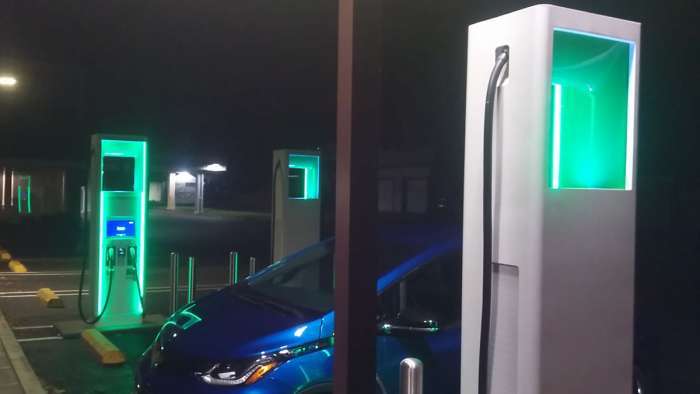
After charging for about 35 minutes, I would drive the 105 miles (1 hour and 40 minutes of driving) to the Recargo charging site in Prunedale with its six 150 kW DC fast chargers. I would have dinner in Prunedale, and charge up for about 45 minutes.
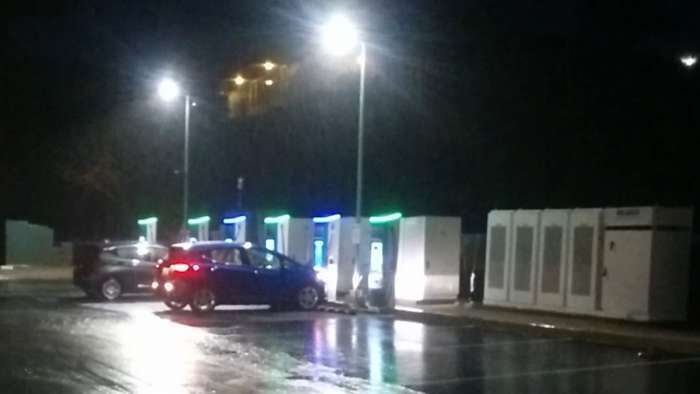
The next stop would be the Vacaville Premium Outlets 135 miles (2 hours of driving), only this time, I would be using the new Electrify America site with eight 150 kW and two 350 kW DC fast chargers. After charging for about 35 minutes, I would head out, and I should be able to cover the last 100 miles of the trip in about 1 hour 30 minutes.
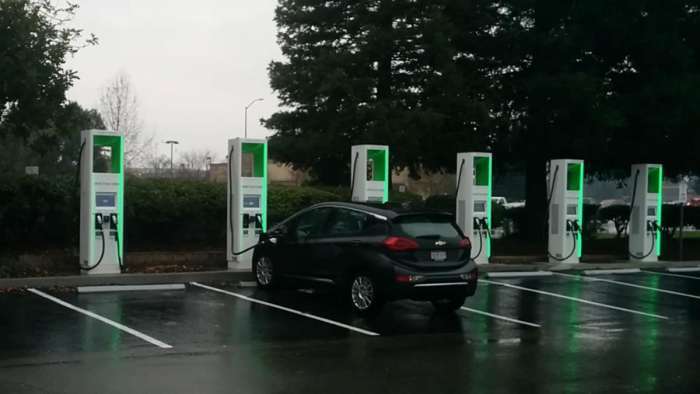
Without major delays due to traffic or weather, the trip today should take a 2017 Chevy Bolt EV owner about 10 hours, which would be considerably faster than the 14 hours the northbound trip took me three years ago. I will likely put this to the test in the next month or so, and I'll report back when I do.
Conclusion
When I first set out for a long trip in my 2017 Chevy Bolt EV, I was still new and inexperienced at using the public charging infrastructure. Despite driving a Chevy Volt for five years by that point in time, I was still a novice at planning my routes, maximizing my charging sessions, and understanding the nuances of the Chevy Bolt EV.
Still, even at that time, I was fully aware that GM had built an electric vehicle that was a step ahead of the public charging infrastructure. In the years that followed, the improvements in public charging support and route availability have brought the Chevy Bolt EV more in line with the average American's expectations for long distance travel. Now that the public charging infrastructure has surpassed the capabilities of the Bolt EV, the ball is now back in GM's court, and they need to push their future EV products even more.
See you next time as I look back at my first Chevy Bolt EV road trip to Zion National Park!
About The Author
Eric Way focuses on reporting expert opinion on GM brand electric vehicles at Torque News. Eric is also an instructional designer and technical writer with more than 15 years of writing experience. He also hosts the News Coulomb video blog, which focuses on electric vehicles, charging infrastructure, and renewable energy. Eric is an active member of the EV Advocates of Ventura County, a volunteer organization focused on increasing the widespread adoption of electric vehicles. You can follow Eric on News Coulomb Youtube, on Facebook at @NewsCoulomb as well as on Twitter at @eway1978.

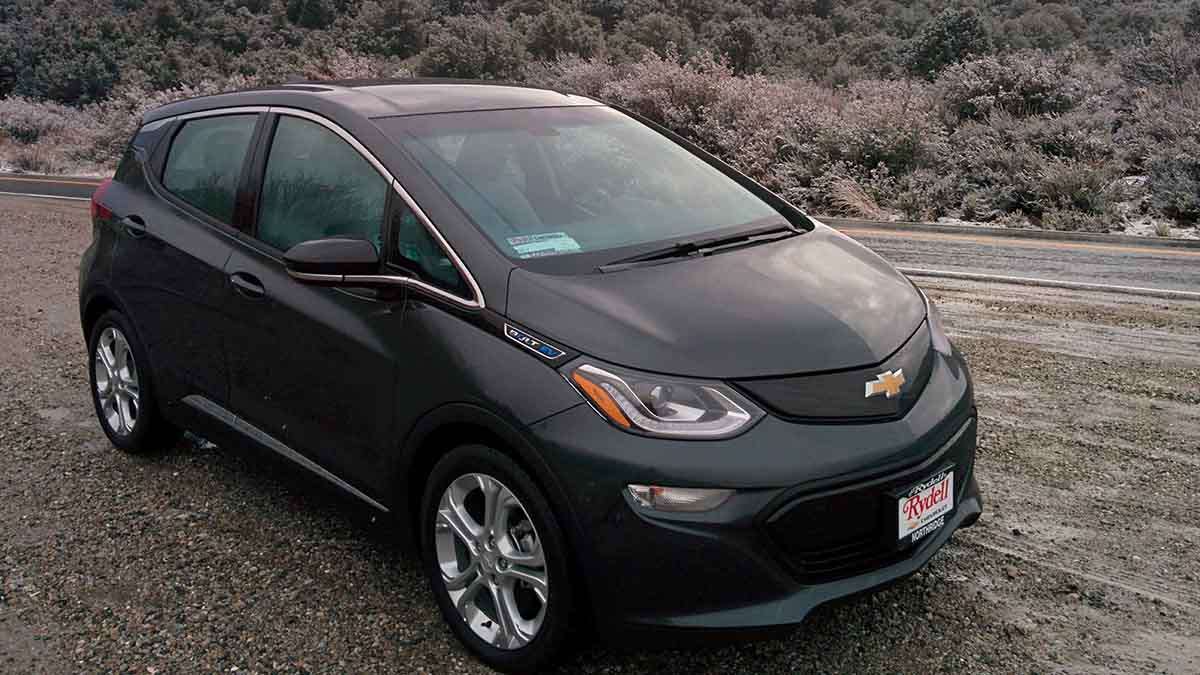




Comments
While you may be in for an
Permalink
While you may be in for an adventure, I would leave our Bolts at home and possibly rent a car for distance travel, but as my Chicago kids moved to Tucson, will fly most everywhere.
Great report Eric and mirrors
Permalink
Great report Eric and mirrors our early experience with the public charging network--or lack thereof. When we first started we were lucky to find Level 2 stations and hotels with NEMA 14-50 outlets. Of course we had a 24 kWh Leaf that required a lot of juggling to get anywhere. ;)
Paul
Amusing seeing your odometer
Permalink
Amusing seeing your odometer with under 1k miles on it... and how much has changed even in the last few months. There are still a few legacy chargers along the 101 down to 40 kW and with the EA expansions they seem so slow.
Really curious how things will look another 2-3 years from now.